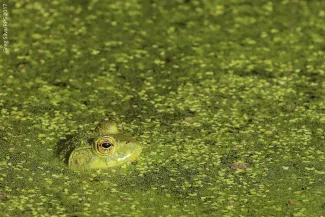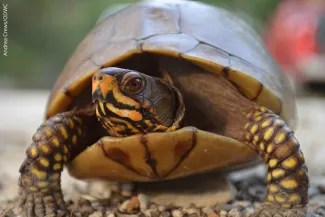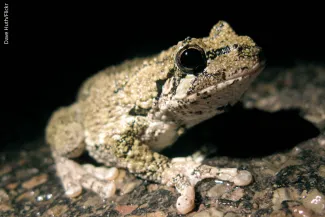Explanations of wildlife surviving freezing temperatures often feature birds flying south and bears retreating to their hibernation den. But these stories rarely address how Oklahoma’s reptiles and amphibians endure our sometimes bitter cold temperatures. Unlike humans, salamanders, frogs, turtles, lizards and snakes do not generate enough metabolic heat or have enough insulation to maintain their body temperature. Instead, they must rely on the surrounding environment and face a life or death challenge when winter air temperatures drop below freezing.
Most reptiles and amphibians fight back with one of three strategies...
An Underwater Retreat

Many aquatic frogs and turtles avoid freezing temperatures by quietly slipping to the bottom of their home pond, lake or stream for the winter. Even when the surfaces of these waterways freeze over, water below the layer of ice remains above the 32 degree threshold.
How can these animals survive months underwater? Their dormant or inactive state requires significantly less oxygen than when these animals are actively feeding, escaping predators or finding a mate. Additionally, amphibians and some reptiles can exchange oxygen and carbon dioxide in ways humans can’t; tadpoles use gills, many amphibians use their permeable skin, and turtles can even use permeable membranes in the throat. The cold water contains sufficient oxygen for the dormant animals and a mixing of surface water and deeper water further oxygenates the water at the bottom of the pond or lake.
Burrow in like a Box Turtle

Burrowing animals like the three-toed box turtle and Woodhouse’s toad rely on their natural digging tendencies to avoid winter’s coldest temperatures. Box turtles often start the winter at ground level under leaves or even brush piles, but can dig nearly 20 inches underground to avoid a deep freeze. Even so, box turtles in one Tennessee study stayed within four inches of the surface throughout the winter. These turtles begin inching toward the surface as winter thaws, and become active aboveground in April.
In addition to burrowing box turtles, many lizards and snakes hibernate in leaf litter, burrow a few inches under the surface, or overwinter in underground dens. Denning reptiles move to the warmest location within the dens as temperatures shift.
Frogs with Antifreeze

Unlike box turtles, land-dwelling animals without strong legs or claws may instead spend winter aboveground in a leaf pile or rotting log and are vulnerable to freezing temperatures. But a few Oklahoma frogs produce “antifreeze” that reduces the amount of ice crystallization at the cellular level. The spring peeper and wood frog can survive below-freezing temperatures by converting glycogen stored in the liver to glucose, while the gray treefrog converts glycogen to glycerol. These antifreeze agents are then distributed to body tissues. These three Oklahoma frogs are also able to relocate water from major organs like the heart and liver and even in skeletal muscles to reduce crystallization.
When temperatures thaw, so too do the frogs. One gray treefrog in a New York study increased its body temperature nearly 15 degrees and increased its heartrate from zero to 10 beats per minute after six hours of thawing.
Although freeze tolerant frogs were noted in naturalists’ journals in 1914, the first scientific demonstration of this process wasn’t offered until 1982.
Helping Oklahoma’s Overwintering Reptiles and Amphibians
While landowners may not be able to realistically control wintertime temperatures in their backyard, they can make a few considerations for overwintering reptiles and amphibians.
- "Leave the leaves" is an increasingly popular wildscape and gardening concept that keeps leaf litter on the ground and provides winter insulation for a number of animals. Nature's mulch not only serves as fertilizer as leaves break down, but may also be a winter hideout for turtles, frogs and salamanders.
- Something as simple as a fallen branch or log covered with leaves may be the perfect shelter for overwintering treefrogs and other wildlife, so let fallen logs lie.
- Small brush piles are a great addition to both urban and rural backyards. Not only do they offer a place for turtles to burrow, but they also provide songbirds shelter from cold winter winds.